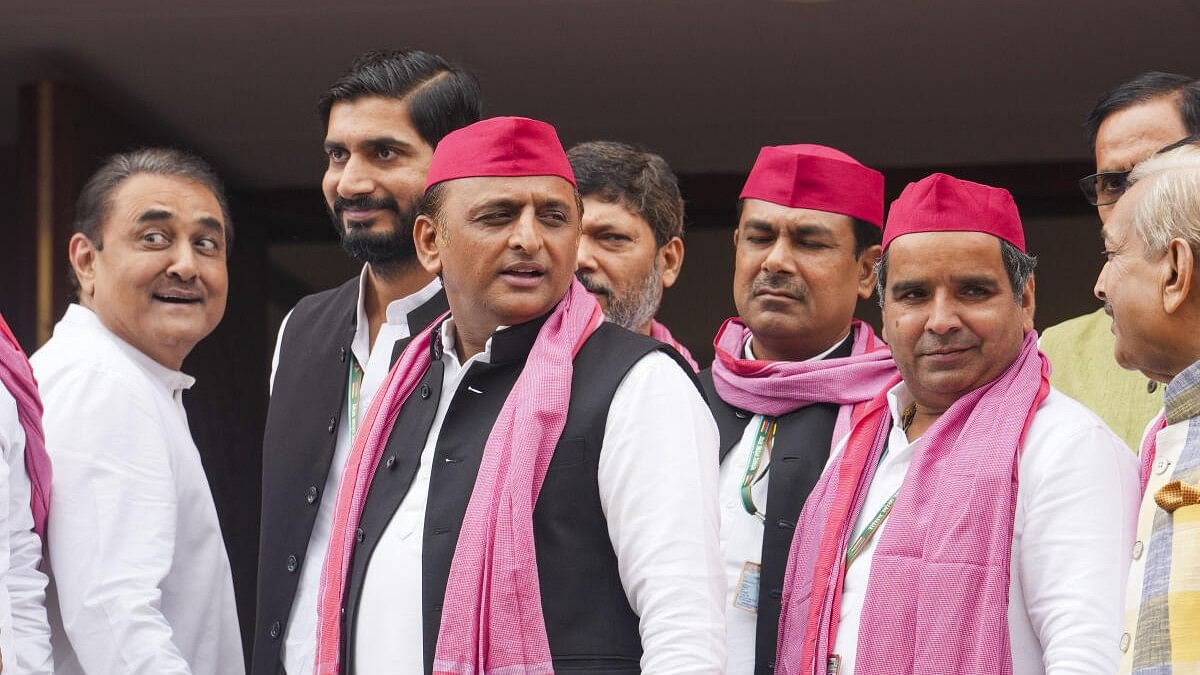
Samajwadi Party MPs Akhilesh Yadav and Dharmendra Yadav, NCP MP Praful Patel and others.
Credit: PTI Photo
On the first day of Parliament, the seating arrangement on the front row of Opposition benches in Lok Sabha was symbolic: between former Uttar Pradesh Chief Minister and Samajwadi Party (SP) leader Akhilesh Yadav and Congress leader and Leader of the Opposition Rahul Gandhi, sat Awadhesh Prasad, the Dalit SP MP from the general category seat of Faizabad who delivered a body blow to the Bharatiya Janata Party (BJP) by winning the constituency that includes Ayodhya. Indeed, many parties in the Opposition now advocate backing Prasad for the post of deputy speaker.
A closer look at the results from UP is warranted because soon the state will be having bypolls to about 10 assembly seats which will test whether the ruling BJP can recover ground since June 4, and whether the tailwinds from the general elections will help the SP.
Woven in the general election results from India’s largest state is a social tapestry that challenges both Hindutva and the BJP’s much-hyped social engineering. In the record heat wave, the Narendra Modi balloon was punctured most systematically by the SP which won 37 seats in Uttar Pradesh, four more than the 33 seats won by the BJP there.
According to the Google Ads Transparency Centre, the SP did not spend on YouTube or Google advertising. The SP did mark a presence on Instagram or Facebook. The party focused on homegrown authentic local messaging by its candidates through adaptations of popular Hindi films and local dialect songs, besides the intense campaigning by the leadership. The SP campaign was diverse, organic, and the complete counter to the BJP’s central message built around Modi.
Indeed, like many incumbents, the BJP partly scripted its defeat and the malfunctions of the Modi era were most visible in the joblessness, leaks of exam papers, and consequent loss of hope among the young. So confident was the BJP that it strutted the catwalk of elections claiming it would cross 400 seats.
It all seemed rather rich, both literally and metaphorically, given the lives on the ground. The disconnect finally caught up and many myths evaporated such as inflation being irrelevant in the face of heightened religiosity.
In UP’s triangular polity, a significant factor was the shift in Dalit votes (SCs make up 21 per cent of the population) and the continued decline of the Bahujan Samaj Party (BSP) which has now slid to fourth position. As BSP chose to shun an alliance, with 9.39 per cent of votes it got zero seats, while the Congress, in alliance with the SP, got 9.49 per cent of votes and six seats.
The alliance worked both ways, and the SP with 33.59 per cent of the votes got 37 seats and the BJP with 41.37 per cent votes, a drop of over 8 per cent from 2019, got 33. Had the BJP not tied up with Jayant Chaudhary’s RLD, it would have fallen further.
The changemakers in many seats were the Dalits trusting the SP, which has not been their traditional choice. Many SC groups wanted to vote against the BJP, and actively protect the reservation guaranteed by the Constitution as the narrative of reserved jobs being systematically cut down had reached the ground for some time now. Simultaneously, the SP genuinely worked on the PDA (Pichda-Backward, Dalit, and Alpsankhyak-minorities) push.
What materialised did not come out of nowhere as the SP did deliver its best-ever vote share in the 2022 assembly election and the party’s organisation has always been intact. There will now be bypolls to 10 assembly seats as many MLAs have become MPs. The general pattern in bypolls is for the party in power in the state to have an edge. Given this, the SP will be tested soon, although the public narrative currently seems to be on its side.
It's as if the atmosphere has suddenly changed in the imagination of the state, and instead of two singular male figures — Modi and Chief Minister Yogi Adityanath —people are now suddenly recollecting Akhilesh Yadav’s languid easy charm, his ability to crack jokes with ease, and as a leader not known for his vindictiveness. Dimple Yadav, now serving her fourth term as MP, is an asset to the SP, and her presence by Akhilesh Yadav’s side also sends a message to women.
Beyond the bypolls, there is a larger political battle to come in 2027 when the state polls take place. The SP assesses that Adityanath will not be replaced as the BJP in the Centre is not strong enough to do so. But as he is from the forward Thakur caste, the SP believes it will hamper the BJP’s recovery among the OBCs and the Dalits.
An SP leader who spoke to this author felt that in the long term, the chances of the BSP being open to an alliance with the BJP (as opposed to covert understandings) could not be ruled out. Mayawati’s public postures recently blaming the Muslims for not standing by her, seems to suggest a dual purpose of stating that the Dalits have not abandoned her, and that the Muslims are to blame for the debacle. Since BJP leaders are frequently found blaming the Muslims, this dovetails nicely into the larger playbook.
(Saba Naqvi is a journalist and author.)
Disclaimer: The views expressed above are the author's own. They do not necessarily reflect the views of DH.